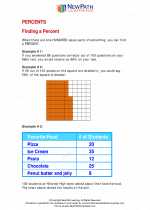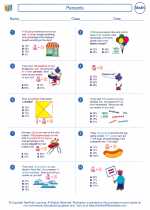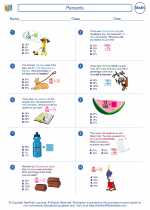Comparing Numbers: Explanation and Study Guide
What is Comparing Numbers?
Comparing numbers is the process of determining the relationship between two or more numbers. When comparing numbers, we are interested in knowing which number is greater than, less than, or equal to another number.Comparing Whole Numbers
When comparing whole numbers, we can use the following symbols:- > (greater than)
- < (less than)
- = (equal to)
- 5 > 3 (5 is greater than 3)
- 7 < 10 (7 is less than 10)
- 4 = 4 (4 is equal to 4)
Comparing Decimals
When comparing decimals, we can use the same symbols as for whole numbers. It is important to align the decimal points when comparing decimals. For example:- 3.14 > 2.5 (3.14 is greater than 2.5)
- 0.75 < 1.2 (0.75 is less than 1.2)
- 5.0 = 5.00 (5.0 is equal to 5.00)
Comparing Fractions
When comparing fractions, we can use the same symbols as for whole numbers and decimals. To compare fractions, it is helpful to find a common denominator. For example:- 1/2 > 1/4 (1/2 is greater than 1/4)
- 3/5 < 4/5 (3/5 is less than 4/5)
- 2/3 = 4/6 (2/3 is equal to 4/6)
Comparing Study Guide
To effectively compare numbers, follow these steps:- Identify the numbers to be compared.
- When comparing whole numbers or decimals, align the numbers on the right side to ensure the place values match up.
- Use the appropriate comparison symbol (>, <, =) to compare the numbers.
- Remember to read the comparison from left to right. For example, when comparing 5 > 3, read as "5 is greater than 3."
- For fractions, find a common denominator if necessary before making the comparison.
◂Math Worksheets and Study Guides Fourth Grade. Percents
Study Guide Percents
Percents  Worksheet/Answer key
Worksheet/Answer key Percents
Percents  Worksheet/Answer key
Worksheet/Answer key Percents
Percents  Worksheet/Answer key
Worksheet/Answer key Percents
Percents 

 Worksheet/Answer key
Worksheet/Answer key
 Worksheet/Answer key
Worksheet/Answer key
 Worksheet/Answer key
Worksheet/Answer key

The resources above cover the following skills:
Algebra (NCTM)
Use mathematical models to represent and understand quantitative relationships.
Model problem situations with objects and use representations such as graphs, tables, and equations to draw conclusions.